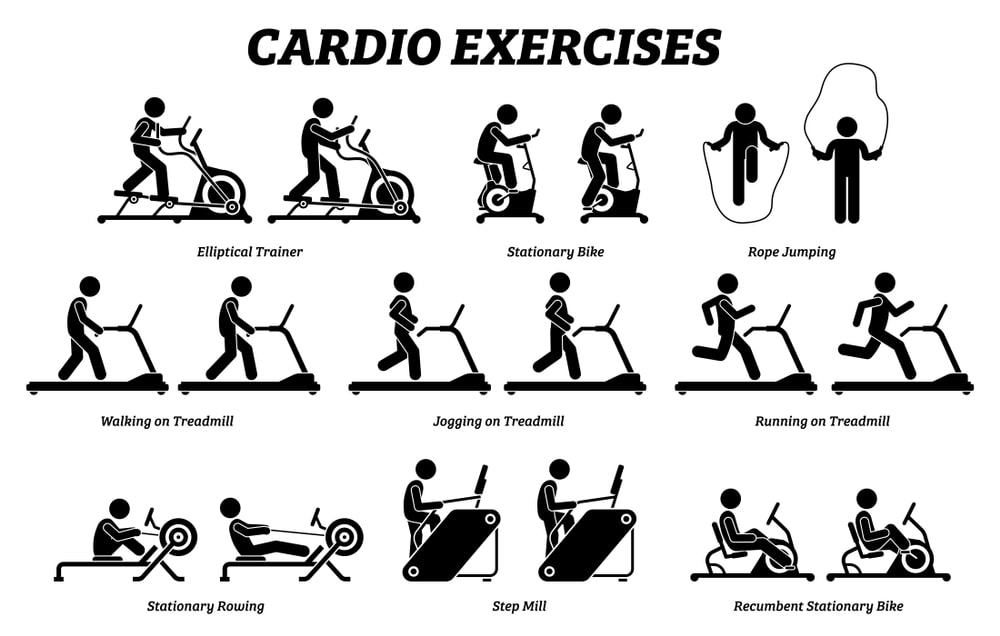What is cardiovascular exercise?

Cardiovascular exercise emerges as a cornerstone in the pursuit of overall health and well-being. Often referred to as “Cardio,” this form of exercise plays a crucial role in maintaining heart health, improving endurance, and contributing to overall fitness. In this blog, we will explore what cardiovascular exercise entails, its benefits, and various activities that fall under this umbrella, and why is cardiovascular exercise important.
Cardiovascular exercise is any activity that raises your heart rate and increases blood circulation throughout the body. It primarily engages large muscle groups, such as those in the legs and arms, promoting cardiovascular and respiratory endurance. The goal is to elevate the heart rate and sustain the activity for an extended period.
Common forms of cardiovascular exercise include running, cycling, swimming, brisk walking, and aerobic workouts. These activities are designed to challenge and strengthen the heart and lungs, promoting efficient oxygen and nutrient delivery to the body’s tissues hence, answers to the question: Why is cardiovascular exercise important?
How does exercise improve cardiovascular health?

Exercise is a powerful tool for improving cardiovascular health, benefiting the heart and circulatory system in several ways. Regular physical activity can contribute to a healthier heart, lower blood pressure, improved blood vessel function, and reduced risk of cardiovascular diseases.
Here are some of the key ways in which exercise positively impacts cardiovascular health and why is cardiovascular exercise important:
- Strengthening the Heart: Exercise challenges the heart, prompting it to pump blood more efficiently. Over time, this results in a stronger and more resilient heart muscle.
- Improving Blood Circulation: Regular exercise enhances blood flow, allowing the circulatory system to deliver oxygen, and nutrients more efficiently to the body’s tissues and organs.
- Lowering Blood Pressure: Exercise helps lower blood pressure by promoting the flexibility and health of blood vessels. It also reduces the resistance that the heart must overcome to pump blood throughout the body.
- Increasing HDL (High-Density Lipoprotein) Cholesterol: HDL cholesterol is often referred to as “good” cholesterol. Exercise has been shown to increase HDL levels, which helps remove LDL (Low-Density Lipoprotein) cholesterol, known as “Bad” cholesterol, from the arteries.
- Reducing LDL Cholesterol: Regular physical activity can lower levels of LDL cholesterol, which, when elevated, can contribute to the development of atherosclerosis (hardening of the arteries).
- Enhancing Cardiac Output: Exercise increases cardiac output, the amount of blood the heart pumps per minute. This improves the efficiency of oxygen delivery to the body’s tissues and organs.
Best cardiovascular exercises:

We now know why is cardiovascular exercise important. The best cardiovascular exercises elevate your heart rate, challenge your cardiovascular system, and contribute to improved overall fitness. The ideal exercise routine often includes a mix of aerobic activities that vary in intensity and engage different muscle groups.
Here are some of the best cardiovascular exercises to consider:
- Running/Jogging: Running is a classic and effective cardiovascular exercise that can be adapted to different fitness levels. Whether on a treadmill or outdoors, it engages major muscle groups and boosts cardiovascular endurance.
- Cycling: Whether on a stationary bike or cycling outdoors, this low-impact exercise is great for building leg strength and improving cardiovascular health.
- Swimming: Swimming is a full-body workout that is easy on the joints. It engages various muscle groups and is particularly effective for improving cardiovascular endurance.
- Jump Rope: Jumping rope is a simple yet highly effective cardiovascular exercise that also enhances coordination and agility. It’s a great option for home workouts or as part of a gym routine.
- Aerobic Dance Classes: Dance-based aerobic classes, such as Zumba or dance cardio, provide a fun and energetic way to get your heart rate up while improving coordination and rhythm.
- High-Intensity Interval Training (HIIT): HIIT involves short bursts of intense activity followed by rest periods or lower-intensity exercise. It is time-efficient and can be adapted to various exercises, such as sprints, burpees, or jumping jacks.
- Rowing: Rowing engages both upper and lower body muscles and provides a low-impact cardiovascular workout. It’s an excellent choice for those looking to diversify their exercise routine.
- Elliptical Training: Using an elliptical machine provides a low-impact workout that engages the arms and legs. It’s suitable for individuals with joint concerns.
- Brisk Walking: A simple and efficient cardiovascular exercise is brisk walking. Because of its low-impact nature, people of all fitness levels can benefit from it.
- Kickboxing: Strength training and cardiovascular exercise are combined in kickboxing exercises. They include bodyweight exercises, punches, and kicks, and they can be done in class or at home.
- Circuit Training: Circuit training is performing a set of exercises one after the other with little to no break in between. This can be a mix of aerobic and strength training, making it a complete workout.
- Climbing Stairs: Whether it’s using a stair climber machine or climbing actual stairs, this exercise engages the lower body and elevates the heart rate.
Why is cardiovascular exercise important?

- Aids in Losing Weight: Exercises involving cardio burn more calories than weight lifting and other forms of exercise. Moreover, exercising increases your metabolism. These workouts raise your heart rate, but they also speed up your metabolism and other bodily functions. Exercise is a key component of weight management, and maintaining a healthy weight is important for cardiovascular health. Regular physical activity helps burn calories and can contribute to weight loss or weight maintenance.
- Enhances Heart Health: It’s a common misconception that your heart is a muscle, and like all muscles, it needs to be worked out. It will deteriorate considerably more quickly if you don’t work on it. Regularly increasing the pace at which your heart beats keeps it in good condition and lowers your chance of heart disease. Cardiovascular disease lowers blood pressure by increasing good cholesterol and decreasing bad cholesterol. Your heart pumps harder as a result, eventually lowering your resting heart rate.
- Enhances Mental Well-Being: Like other physical activities, cardio is excellent for mental well-being as well. Any cardiovascular exercise causes your body to release endorphins, which are feel-good chemicals. Physical activity is known to reduce stress hormones, such as cortisol, and trigger the release of endorphins, which are natural mood elevators. Chronic stress is a risk factor for heart disease, and exercise can contribute to stress management.
- Boosts Immune System Power: Your heart rate rises with cardio, widening your blood vessels in the process.
- Increases Intelligence: Cardiovascular exercise can assist your brain as well.
- Boost Your Sleep: Cardiovascular activity performed throughout the day may help you sleep better if you have trouble getting or staying asleep.
- Enhanced Respiratory Function: Cardio improves lung capacity and efficiency, promoting better oxygen exchange and respiratory health.
- Increased Energy Levels: Regular cardiovascular activity improves circulation and energy production, leading to increased stamina and vitality.
- Reduced Risk of Chronic Diseases: Cardiovascular exercise has been linked to a decreased risk of various chronic conditions, including type 2 diabetes, certain cancers, and metabolic syndrome.
- Promoting Healthy Blood Sugar Levels: Regular exercise improves insulin sensitivity, helping the body better regulate blood sugar levels. This is particularly important for reducing the risk of type 2 diabetes, which is a risk factor for cardiovascular disease.
- Reducing Inflammation: Chronic inflammation is associated with the development of cardiovascular diseases. Exercise has anti-inflammatory effects, helping to reduce inflammation in the body.
- Enhancing Endothelial Function: The endothelium is the inner lining of blood vessels. Exercise improves endothelial function, promoting vasodilation (expansion of blood vessels) and maintaining health.
FAQs:
Is cycling cardiovascular exercise?
Yes, Since cycling is primarily an aerobic activity, it works your heart, blood vessels, and lungs. You will become more physically fit overall as a result of deeper breathing, more sweating, and raised body temperature. Regular cycling has several health benefits, including improved cardiovascular fitness.
Does cardiovascular exercise lower blood pressure?
Yes, it does lower the blood pressure. The heart gets stronger with regular exercise. More blood may be pumped by a stronger heart with less effort. The pressure on the arteries lessens as a result. Blood pressure is lowered as a result. It helps the blood pressure and hence, helps answer the big question: Why is cardiovascular exercise important?
Is swimming a cardiovascular exercise?
Yes, it is a cardiovascular exercise. Regular swimming allows you to exercise your body in a multitude of ways while also providing several health benefits. This implies that you develop both muscular strength and aerobic endurance (particularly in the shoulders, back, and core).
Is yoga a cardiovascular exercise?
No, Yoga is a calming exercise that helps the heart. Your pulse rate doesn’t stay raised while holding each pose, thus it wouldn’t be classified as cardio.
How does cardiovascular exercise affect brain structures?
Yes, it increases the blood flow and hence affects the healing of brain structures. Hence, it clears the question: why is cardiovascular exercise important?
References:
- https://fitness-nation.net/2020/06/25/cardio-and-why-its-important/
- https://www.abbott.com/corpnewsroom/healthy-heart/cardiovascular-fitness–what-it-means-to-your-heart-health.html



Comments are closed.